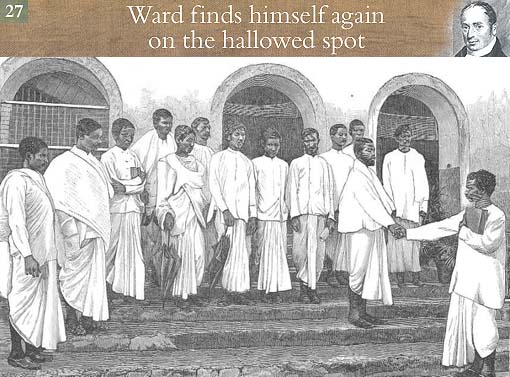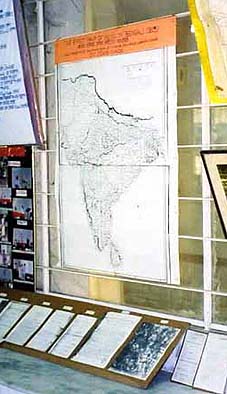

'Native divinity students, Serampore College.' Courtesy 'The Centre for the Study of the Life and Work of William Carey D.D., 1761 - 1834.' Ward reached Serampore on 20th October, 1821. In letters to England, he describes the ecstasy of his feelings on finding himself again on the hallowed spot. He dwelt on the pleasure he felt in exchanging the freezing atmosphere of Fen Court for the genial associations of the family circle at Serampore, the progress which had been made in the erection of the college buildings, in the assemblage of students, and the arrangement of the classes, exceeded his most sanguine expectations. When he contrasted the extraordinary exertions and sacrifices which had been made by his colleagues during his absence, with the charges of secularity and self-aggrandisement which had met him at every turn in England, he felt bound to them by stronger ties.
Ward returned to his labours and resumed charge of the Printing Office and of the secular departments of the mission. He worked the 19 presses with diligence in the printing of the Scriptures and tracts; but the object to which his chief attention was given was the training of the more advanced youth in the college for missionary duties. He commenced a religious magazine in Bengali, and encouraged them to contribute to it. He likewise established an auxiliary missionary society among the native Christians. Places of worship were erected in several places in the town, and the sabbath day was more particularly devoted to addresses to the heathen; and the Christian students of the college were thus exercised in their future duties.
Ward revised the manuscript of 'Reflections for every day of the year,' (1) which he had compiled on his voyage to England, and published it in two volumes of moderate size. The work was highly prized by his Christian friends and brought into daily use in many families.
In the 1822 Report it was stated that the New Testament had been published in 20 languages of India. The 6th edition of Scriptures in Bengali, and a 2nd in Hindi, Sanskrit, Oriya and Mahratti Scriptures were in the Press. Of these versions, some had been 12 years in progress, but 7 years was the shortest period occupied in translating and printing any version of the New Testament.
Carey and his colleagues had divided the versions into two classes; primary and secondary. The languages of secondary importance were current in large principalities, and may be more aptly termed provincial dialects, three-quarters of the words being derived from a common source.
They had also begun translations of the New Testament in 9 other dialects. Their report was accompanied by a miniature map of India with the areas where each language and dialect was understood to be current, marked by a distinctive colour. (2)
The expense of these undertakings had exhausted the resources of the missionaries and compelled them to obtain accommodation from their bankers at the heavy interest of the day. In the course of the preceding 3 years, the erection of the college buildings had taxed their resources to the extent of £15,000, and they had the expense of 10 missionary stations on their funds. To these severe burdens was now added the responsibility contracted in connection with the translations. Ward's mind was filled with the most gloomy forebodings.
'We have,' he writes, 'dismissed some of the pundits, and put off some editions of the Bible. Dr. Carey is alarmed. I do not see how we can go on when we have an obligation of £10,000 on the translations hanging like a millstone round our knecks, and dragging us down to disgrace and ruin. We cannot get on with anything for want of funds, and we are too heavily in debt to be able to borrow.'
As new prospects of usefulness were unfolded, they hastened to take advantage of them, without any rigorous attention to the dictates of prudence. They may be said to have reached the zenith of their exertions. From this time forward their efforts were limited to the objective of maintaining the ground they already occupied.
John Mack entered on his duties in the scientific department of the college, and undertook the general superintendence of the classes. The number of students at the close of the year 1822 was 50, of whom 15 were in the preparatory class, and 35 engaged in the higher studies of the college. While Mack was engaged in giving secular instruction, Ward undertook the charge of the theological department and they laboured together with the greatest harmony.
One of the most pressing wants of the college was that of maps in the native language. There appeared to be no means of supplying it in India. Lithography (3) was unknown in India and there was no native skilled in the art of copperplate engraving. It was necessary therefore that the maps should be executed in England, and the missionaries resolved to begin with a map of India. The names of more than 1,000 towns and rivers were printed in alphabetical order in English, with the Bengali equivalent side by side. The work was sent to Mr. Walker, the eminent artist in London, who compiled and engraved the first map which had ever been executed in any native language.

The first map of India in any native language in the Carey Museum, Serampore. Courtesy of the Rev. Peter Shepherd, Broadway Baptist Church, Derby.
The year 1822 was a season of mortality such as had not been witnessed in Calcutta and its neighbourhood for more than half a century. The cholera, which first made its appearance in Jessore, and on the banks of the Chonbul, in 1817, was now reckoned among the permanent diseases of the country. The superstitious natives regarded it as a new incarnation of the goddess of destruction, and instituted a special form of religious service to propitiate it. To the ravages of this mysterious disease was added, in 1822, a more fatal type of the fever which generally prevailed at the close of the rains. The obituary of the year was the heaviest on record.
Mr. Chamberlain was returning to England on account of his health and, after about 3 weeks at sea, he was found dead in his cot. Krishna-Pal, the first native to be baptised by the missionaries was struck down by cholera. The Bishop of Calcutta, Dr. Middleton, was carried off by fever. The archdeacon took charge, but in less than 2 months he was carried to his grave. Carey's son Felix Carey was also a victim. A few days after Felix's death Carey was also attacked with fever, which in such a season of mortality, created the deepest anxiety. 'We trembled,' writes Ward, 'for the result. His death would have stopped our steam engine, and emptied the printing office;' but his valuable life was spared, and he was able to resume his important labours.
In the course of 8 months the number of deaths in the missionary circle alone amounted to 20, and a general gloom pervaded all ranks of society.
'We are surrounded,' again writes Ward, 'with the groans of the dying and the lamentations of the bereaved; every day presents new victims. Such a season has never been known. We appear like prisoners listening for the footsteps of the sheriff, and the turning of the key of our cell.'
The Governor-General, Lord Hastings, was now about to quit the Government of India, after having administered it since October, 1813. Before his departure he signified his intention of paying a farewell visit to Serampore, but the multiplicity of engagements in his last week of office prevented him from doing so. Lady Hastings, therefore, came alone, and passed 2 hours in visiting the schools, the Printing Office, the foundry, the translation room, and the college; and expressed her own, and Lord Hastings esteem for the labours which had been so assiduously and successfully prosecuted.
(1) A copy of this book is in the collection of the Derby Local Studies Library entitled 'Reflections on the Word of God for every Day of the Year', by the Rev. William Ward of Serampore. Printed for W. Simpkin and R. Marshall, Stationers' Court, Ludgate Street, London. 1835.
(2) To see a reworked version of the map showing just the areas covered by the different languages and using the original names and spellings click on the link.
(3) The printing technology that supplanted letterpress in the late 20th century; based on the principle that oil repels water.